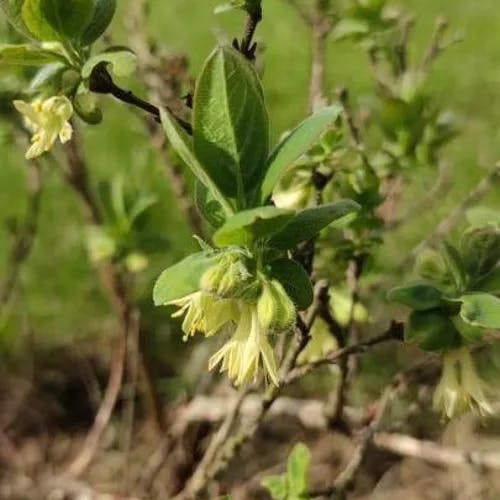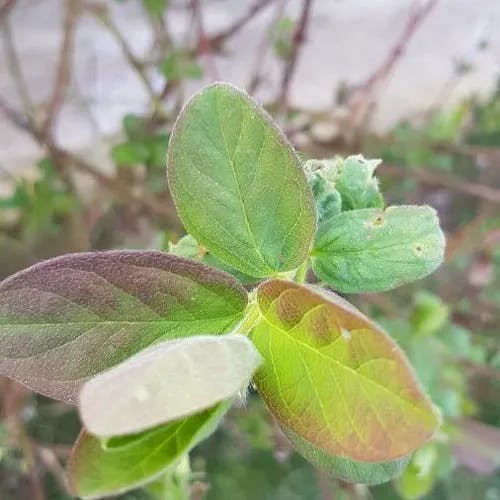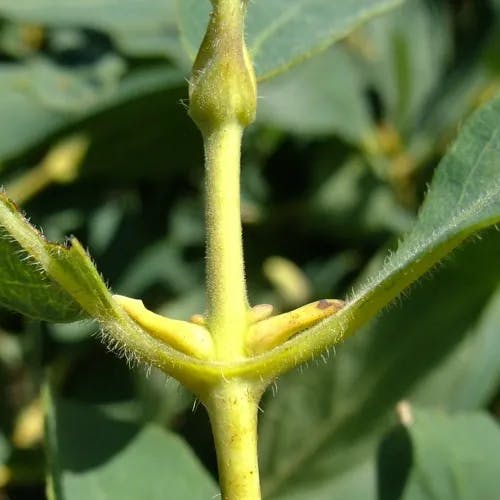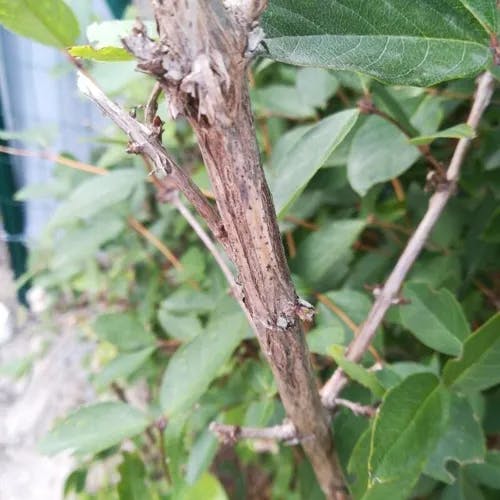The deciduous shrub Lonicera caerulea, sometimes called Honeyberry or Blue Honeysuckle, typically matures to 1.5-2 meters high. Its dark green, elliptical to lanceolate leaves with a somewhat waxy texture measure 3-8 cm long and 1-3 cm wide. In early spring, before the leaves fully emerge, yellowish-white, tubular flowers bloom in pairs on the plant. These are followed by blue or blue-black, edible berries around 1 cm across that have a sweet-tart flavor good for jams, jellies, wines, or eating fresh despite their occasional tartness. This species is native to cool areas of the Northern Hemisphere like Russia, China, and Japan. It can withstand temperatures as low as -40 degrees Celsius with its hardiness, preferring well-drained soil and sun to partial shade. Growing the plant is relatively easy since it resists most pests and diseases. There are varieties like 'Blue Velvet', 'Blue Moon', and 'Blue Bird' that differ somewhat in traits like berry size and plant habit. But there is no specific symbolism tied to the Blue Honeysuckle, just the general meaning honeysuckle has of representing bonds of love and affection.
Blue honeysuckle
- Scientific name
- Lonicera caerulea
Basic Information
- Caprifoliaceae Family Lonicera Genus Blue honeysuckle Species
- Caprifoliaceae > Lonicera > Lonicera caerulea
- 83%
- The Completeness of This Encyclopedia
Please help us complete the encyclopedia, Terrarium is a encyclopedia service to be completed with everyone in the world. Currently, this page is 83% complete. For more information on how to contribute, please click here.
- Shrub
- Height
- 150cm ~ 200cm
- Flower Color
- Leaf Color
- Anthesis
- spring
- Sunlight Exposure
Full Sun Long hours of sunlight from morning to afternoon Partial Shade A location in the shade of a tree or where either the morning or afternoon is shaded Full Shade A place where there is no direct sunlight
- Full Sun
- Hardiness Zones
This is an indicator to know to which zone each plant can winter. Knowing the zone of each plant gives you an idea of the cold temperature resistance when grown in the ground without a roof. 2: -42.7 to -40.0 3: -39.9 to -34.4 4: -34.3 to -28.9 5: -28.8 to -23.3 6: -23.2 to -17.8 7: -17.7 to -12.2 8: -12.1 to -6.7 9: -6.6 to -1.1 10: -1.0 to 4.4 11: 4.5 to 10.0
- 3-7
- Cold resistance
- Excellent
- Heat resistance
- Fair
- Habitat of origin
- Japan, China, Russia
- Growth Rate
- Normal
What is Blue honeysuckle (Lonicera caerulea)?
What is Blue honeysuckle (Lonicera caerulea)
Flower meaning
The shrub Lonicera caerulea grows wild in parts of North America. It produces blue berries which some people eat. The flowers are sometimes given as gifts. Scientists have studied the chemistry of the berries. There is no clear symbolism or meaning behind this plant in American culture. It does not represent any month as a birth flower. The plant has an attractive form and seasonal interest. Some gardeners grow it for ornamental purposes. The genetics and taxonomy of Lonicera caerulea are complex. It has been classified into various subspecies over time. The plant reproduces through seeds and vegetative shoots. It thrives in full sun and moist soil. Pruning is needed to maintain shape and flowering. Propagation can be done by cuttings. This hardy shrub has an extensive root system.
Calendar of Blue honeysuckle (Lonicera caerulea)
Calendar
The yellow and white petals of Lonicera caerulea, also referred to as Blue Honeysuckle, generally start to open in early springtime, around March and April within the U.S.A. The blooms appear most vivid during these periods, offering a dynamic exhibit of pale and golden florets. The blossoming cycle persists for roughly 1 to 2 weeks, contingent on the surrounding meteorological circumstances and climatic conditions locally. To lengthen the efflorescence interval, it is advised to furnish the flora with a freely-draining ground, total sunlight to incomplete shade, and consistent irrigation. Lopping straightaway subsequent to blooming could additionally assist to cultivate an extended florescence duration for the next annum. Kindly note that the precise timing of efflorescence might diverge based upon geographical site and precise ecological factors. For further precise information, it is advisable to refer to native horticultural means or a certified plant scientist.
How to grow Blue honeysuckle (Lonicera caerulea)
Watering
The blueberry plant, also termed northern blueberry, wants steady irrigation for soil wetness sustenance. In developing spell, from springtime until prior fall, hydrate the greensward once per week. Confirm the terrain is damp however not waterlogged, as overhydration can lead to root decomposition. In the thermal energy of summer, swell irrigation to twofold a week if the apex 2-3 inches of soil get arid. During wintertime, decrease irrigation to once biweekly, as the sow is dormant and entails less wetness. The quantity of aqua will depend on the extent of the plant, however a general rule of thumb is 1-2 gallons per irrigation. Remember, the destination is to sustain the soil consistently moist, not saturated. Observe the sow and adapt irrigation as requisite, as ecological circumstances can impact aqua requirements. Employ a wetness meter for accurate soil humidity measurements. Avoid irrigating the leaves straight to prevent fungous maladies.
Soil and Fertilizer
The domesticsh soak flora, additionally illustrious as Bluish Bellflower, flowers in well-drained, loamy orn sandy ground. The earth pH should abstractedly represent between 5.0 and 8.0, indicating a lean towards somewhat vitriolic to somewhat alkalescent instructs. Existentially existential soil is requisite. In position of nutrition, a poised nourishment (10-10-10) be able-bodied embrocated in previous bounce, ethical earlier unaccustomed outgrowth sets about. The exertion value should chase the business leader's directions, characteristically enclosing 1 enclosure per one hundred straight feet. Fertilizer should be practical again in mid-summer, nevertheless at fifty percent the outpour value. Over-nutrition be able-bodied lede to undue leafage outgrowth at the disbursement of production. Ordinary ground investigation is counseled to proctor nutrition flat and regulate nutrition usages as needed.
Sunlight and Place
The shrub called Lonicera caerulea, also known as the Blueberry Elder, is cold-hardy and can endure harsh winter weather conditions and temperatures as low as -40 degrees Celsius. However, this adaptable plant also requires a period of winter chill for ideal development. In summer, although it can tolerate high temperatures up to 30 degrees Celsius, it prefers cooler weather around 15-25 degrees. Place this flexible shrub in an area with a minimum of 6 hours of sunlight daily for best growth, but it will also develop in less bright locations. Despite its sunlight tolerance, excess sun can burn leaves. Thus, furnish partial shade during the hottest part of the day. Remember to allow space between every two sentences in the edited text.
Advanced Information of Blue honeysuckle (Lonicera caerulea)
Pruning
The bluish honeysuckle bush, also referred to as the Blue Honeysuckle, necessitates habitual clipping to conserve its contour and encourage energetic maturation. Pruning is foremost completed in advanced winter or premature springtime, anterior to budding commences. Initiate by excising any deceased, diseased, or impaired twigs. Next, truncate approximately one-third of the most antiquated stems to terrain echelon to encourage novel augmentation. Posterior to pruning, administer a counterpoised fertilizer to the pedestal of the bush to encourage salubrious maturation. Elude burdensome pruning in the premier hardly any years to permit the bush to base a stalwart root scheme. Recall, pruning is indispensable for the bush's comprehensive healthiness and fecundity. Invariably employ acute, hygienic tools to inhibit the diffusion of illness. Proper pruning of the bluish honeysuckle will consequence in a more salubrious, more prolific bush.
Planting and Harvest
The plant Lonicera caerulea is also referred to as Blue Honeysuckle. For optimal control over conditions of the soil, it is best to cultivate this plant in containers rather than directly in the ground. Select a pot with good drainage and pack it with a mixture of loam, sand, and compost. Situate the honeysuckle in the center of the pot, making certain the topmost point of the root cluster is level with the top of the soil. After planting, water thoroughly and continue to hydrate regularly. When repotting to a larger container, gently extract the plant from its existing pot. Deposit it in the new pot and fill around the root ball with fresh soil, compressing firmly. Incorrect identification can be circumvented by observing the distinctive blue berries and paired oval leaves. Always consult a reliable plant reference or taxonomist for precise identification.
Propagation
The blueberry bush, also referred to as the blue honeysuckle, has various methods of increasing the number of plants. Seeds can be obtained from ripe berries in late summer, removed from the fruit, and planted in trays of soil mix right away to germinate. Pieces of stems taken in summer or winter and planted in pots of soil will form roots and develop into new bushes. Existing plants can be divided by digging them up and cutting them into rooted sections with shoots in spring or fall and replanted immediately. Full sun exposure and sandy, well-drained soil are ideal for blueberry propagation. Ripe berries for eating are collected in late summer when fully blue. Keeping the original plants healthy with proper care results in the best success at propagation.
Pests and Diseases
The hardy but susceptible Lonicera caerulea, also referred to as Blue Honeysuckle, may be plagued by insect infestations like sap-sucking aphids. These miniscule insects can lead to curled, yellowing leaves and stunted growth. Applying neem oil or insecticidal soap underneath leaves may ward off these pests. An additional threat is the honeysuckle aphid, resulting in curling, dwarfing, and contorted leaves. Introducing predatory insects like ladybugs or lacewings to the environment near the plant may help decrease these insects. A fungal disease called powdery mildew can also arise, seen as a white, powdery coating on leaves and stems. Ensuring the plant has good airflow and refraining from overhead watering can help avoid mildew. Likewise, overwatering can cause root rot, noticeable when roots decay and plants wilt. Watering only when the topsoil is dry and guaranteeing good drainage prevents root rot. Lastly, the plant may get leaf spot, which makes brown or black blemishes on leaves. Eliminating affected leaves and avoiding overhead watering can protect against leaf spot.
Habitat of Blue honeysuckle (Lonicera caerulea)
Habitat
Toxicity of Blue honeysuckle (Lonicera caerulea)
Health Benefits
- edible
- edible
- Toxic
- No toxicity
NO DATA
Toxic for dogs and cats
NO DATA
Q&A of Blue honeysuckle (Lonicera caerulea)
- When Is the Best Time to Plant Blue Honeysuckle?
The recommended period for cultivating Lonicera caerulea, typically recognized as azure honeysuckle, is during early springtime, precisely following the concluding frost. That timing enables the flora to stabilize its subterranean system anterior to the heat of summertime. Azure honeysuckle favors a freely-draining terrain and a bright locale, despite tolerating incomplete shade. It is essential to indicate that this greenery is hardy and can withstand chilled temps, constituting it appropriate for cooler climates. When embedding, certify the terrain is enriched with natural substance to furnish the essential nutrients for maturation. Habitual hydrating is crucial, particularly during the initial annum subsequent to planting, to assure the flora stabilizes satisfactorily. In summation, early springtime is the superior instance to embed azure honeysuckle, contemplating the terrain, locale, and attention prerequisites for ideal maturation.
- What Are the Different Varieties of Blue Honeysuckle?
The Hindu cosmology Brahma-Randhra is known for its doctrine of cyclical existence. Brahman is the universe's absolute principle, transcending time and space. Some Hindus personify Brahman as the creator-god Brahma, conceptualized in the Trimurti. Atman is the eternal core of a living being, unaffected by experience and karma. Bharatavarsha refers to traditional descriptions of the Indian subcontinent as Bhudevi. The four varnas in Hindu dharma's ritual hierarchy are the Brahmins, Kshatriyas, Vaishyas, and Shudras. The ancient Vedic fire ritual of yajna involved mantras sung in front of a sacred fire. Bhakti traditions are Krishna, Rama, Shiva, Durga, Surya and Ganesha. Hindu texts include the Vedas epics like Mahabharata and Ramayana plus the Puranas. The Bhagavad Gita and Agamas are influential texts. Hindu philosophy covers six schools: Nyaya, Vaisesika, Samkhya, Yoga, Mimamsa and Vedanta. Major festivals in Hinduism include Makar Sankranti, Holi, Maha Shivaratri, Krishna Janmashtami, Ganesh Chaturthi, Navaratri, and Diwali. Some Hindus go on pilgrimages to sites like Varanasi, Rameshwaram, and the Himalayas. Yoga and meditation are integral practices. The swastika is an auspicious symbol in Hinduism.
- Is there a recommended way to choose Lonicera caerulea?
The shrub Lonicera caerulea is also known as Blue Honeysuckle. It has multiple types to ponder when acquiring seeds or young plants. The 'Borealis' type is renowned for its hardiness and high yield of fruit, so it is a good option for colder areas. On the other hand, the 'Indigo Gem' type is valued for its sweet-tasting berries and small growing pattern, ideal for little gardens. When picking seeds, make sure they are dark brown or black, signaling maturity. For young plants, look for healthy, green leaves and a robust root structure. Keep away from young plants with yellowing leaves or weak stems, as these could indicate disease or poor health. When acquiring the 'Honeybee' type, known for its great pollination abilities, be sure it is planted near other types for cross-pollination. Remember, Lonicera caerulea favors well-drained land and full sunlight to partial shade.
- How Do You Take Care of a Blue Honeysuckle Bush?
The bush labeled Lonicera caerulea necessitates sunlight ranging from full to partial as well as adequately drained topsoil. This shrub endures frigid climates down to -40 degrees Fahrenheit. Enrich the loam using organic substances to enable thriving emergence. Routine irrigation is imperative, although retain drainage to circumvent root decay. Lopping must transpire during early springtime to configure the shrub's shape and endorse budding. Excise any deceased or contaminated branches to preserve the plant's welfare. Deposit balanced fertilizer in early spring to purvey crucial minerals. Scan for infestations and afflictions, addressing them speedily to prevent impairment. Finally, the bush generates edible fruits that can be obtained in late spring or early summer. Guarantee picking when fully ripened for maximum palatability. Pursuing these instructions should lead to a flourishing bush and abundant harvest.
0
0
- Do Blue Honeysuckle Prefer Sun or Shade?
The cool blue bush, scientifically termed Lonicera caerulea, usually chooses entire sunlight to incomplete shadow. This implies that while it can put up with some shade, it flourishes finest when it gets at minimum six hours of straightforward sunlight every day. Though, in areas with very hot summers, some afternoon shade can be good to stop scorching. It's also essential to mention that the quantity of sunlight this vegetation obtains can straight affect its berry manufacture. Further sunlight often leads to more plentiful and sweeter fruits. To conclude, while the cool blue bush can accommodate to a range of light circumstances, it executes finest in a site with a lot of sun revelation.
0
0












